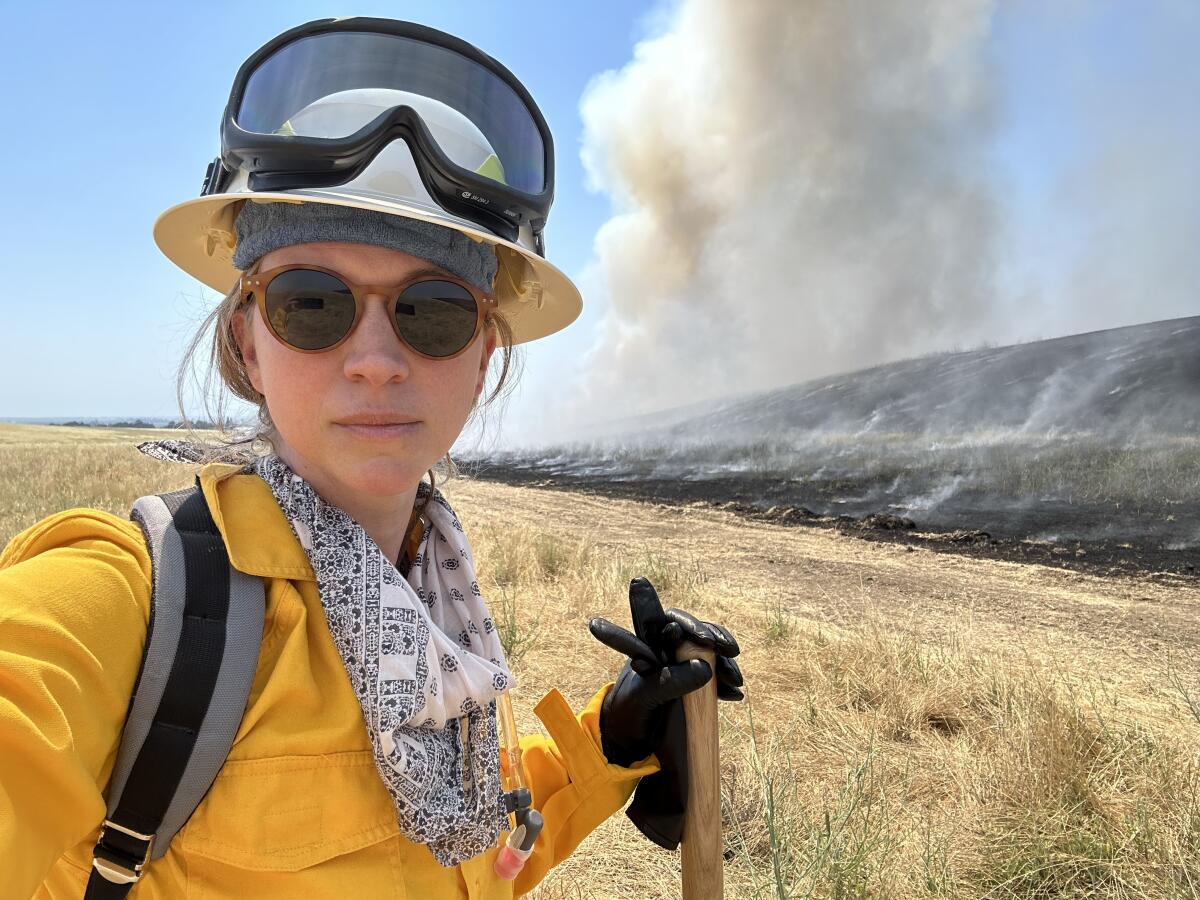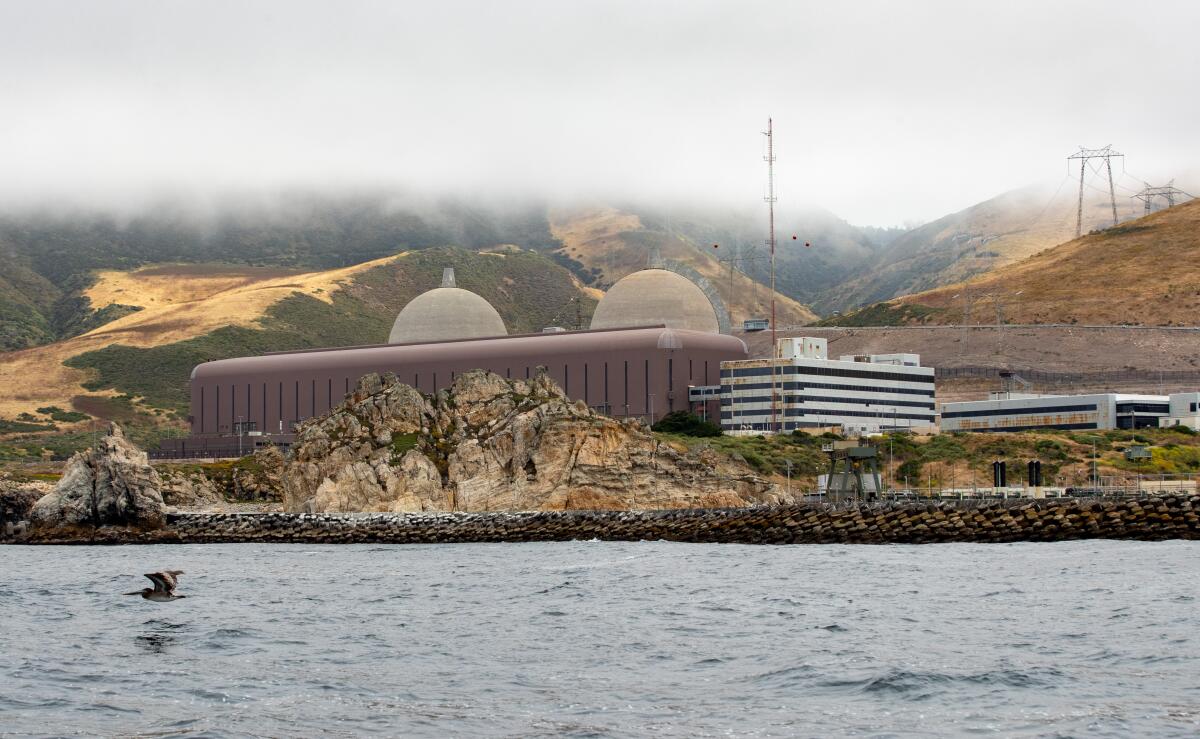Column: Stand down, Smokey Bear. Burnie the Bobcat wants to start good fires

- Share via
The newly installed billboard off Interstate 80 offers a badly needed twist on eight decades of firefighting dogma.
Its message: “Only you can decide our fiery future.”
When I wrote last month that Smokey Bear and his “only you can prevent wildfires” slogan have become sadly outdated — with climate scientists telling us our history of aggressive fire suppression has actually resulted in bigger, more destructive blazes by stopping forests from trimming themselves — I didn’t think there would be such a good solution in my inbox so quickly.
But then I got an email from Emily Schlickman, a professor of landscape architecture and environmental design at the University of California, Davis. She told me that she and one of her colleagues had created a new Smokey-esque character called Burnie the Bobcat, and Burnie would be making her debut on a billboard between Sacramento and Davis shortly.
You're reading Boiling Point
Sammy Roth gets you up to speed on climate change, energy and the environment. Sign up to get it in your inbox twice a week.
You may occasionally receive promotional content from the Los Angeles Times.
And by total happenstance, Burnie would replace a billboard that featured Smokey.
“What if Smokey got a buddy? And what if this buddy had a little bit more of a nuanced perspective?” Schlickman asked when I called her up. “What if Smokey was all about avoiding bad fires, and this buddy was all about promoting good fire?”
In other words, what if we could stop fearing all wildfires and start accepting the benefits they can bring?
Schlickman has spent several years working with her colleague Brett Milligan on a book about learning to live with fire, and more recently developing an exhibit, Pyro Futures, for UC Davis’ Manetti Shrem Museum. The exhibit will present three possible visions of California’s future: one in which we take serious action to fight climate change, while also giving people in fire-prone towns the support they need to relocate; one in which climate-fueled conflagrations grow wildly out of control; and another in which Native American tribes are given much greater rights to carry out cultural land-burning practices, helping forests stay healthy.
Burnie the Bobcat is an outgrowth of that forward-looking vision.
Originally, Schlickman said, she wanted to “give Smokey a drip torch and give him fire-lighting gear instead of firefighting gear.” But with copyright protections, that wasn’t going to happen. So she and Milligan started looking at “pyrophilic” animals that can benefit from fire, such as woodpeckers that take up residence in scorched trees. They ended up brainstorming half a dozen cute animal mascots on which museum visitors will get to vote, including Cinder the Coyote, Flame the Fox and Torchy the Tule.
The billboard outside Sacramento, which went up last week , is a test run for one of those characters, Burnie the Bobcat. It’s Schlickman’s favorite mascot thus far. She told me bobcats are generally good at escaping fires, with the predators eventually “reaping the benefits of healthier, robust vegetation that supports prey population” after the flames die down.
“My hope is that this is a starting-off point for a larger campaign,” Schlickman said.
She’s a worthy messenger.
While on maternity leave a year ago, she told me, she “got bored” and decided to take online training classes for lighting controlled burns — fires started on purpose during optimal weather, to cut down on forest overgrowth and prevent worse blazes later. She had to pass an endurance test that required her to walk three miles carrying 45 pounds in 45 minutes.
Since then, she’s worked on several controlled burns in Northern California, alongside experienced crews. She remembers one of the burns was fast and hot, with 30-foot-high flames that were gone in 45 minutes. Another was a “slow rambling burn.”
On her second burn, she was part of an Indigenous-led crew. When she announced she had to go home to take care of her six-month-old son, one of her Native American crewmates turned to her and asked, “Why don’t you bring him next time?”
Schlickman hasn’t done that, at least not yet. But her six-year-old daughter keeps asking to join her.
“With cultural burning, it’s really a family event,” she said. “Often you’ll get toddlers there, safely outside the line of fire.”

The idea of embracing “good fire” — a term that Schlickman sees as overly simple, but useful — flies against decades of government-led messaging encouraging us to snuff out flames at all costs. There’s good reason that message continues to resonate. Wildfires kill people. They destroy homes and knock out power. They fill the air we breathe with toxic chemicals.
But especially with climate change driving bigger and more destructive fires — which in turn cause trees to release even more heat-trapping carbon into the atmosphere — we need to start changing the way we see and engage with the world.
Ending the combustion of planet-warming fossil fuels will require us to embrace a wide range of clean energy solutions, some of which we’re predisposed to dislike — such as sprawling solar farms that can destroy wildlife habitat, towering wind turbines that can mutilate migratory birds and rooftop solar panels that critics say are too expensive and shouldn’t be subsidized.
Similarly, adapting to the rising temperatures already affecting our daily lives will require new ways of living.
That could mean pulling back our coastal homes as the oceans rise, or taking trains and buses instead of personal cars. With fires, it means accepting the slight risk of a controlled burn spiraling beyond our control — which does happen once in a great while — as a worthy sacrifice for dramatically reducing the risk of an uncontrolled blaze wiping out a town such as Paradise, Calif.
Letting Burnie the Bobcat tell that story probably makes more sense than trying to update Smokey Bear.
“We can’t touch Smokey,” Schlickman said. “So what else can we do?”
The museum exhibit will be on view in Davis from January through June. It was developed with support from fire ecologists and other experts, with Schlickman and Milligan using an artificial intelligence platform to help design Burnie and the other possible “good fire” mascots. Their work has been funded by UC Davis so far, with their longer-term vision of a national campaign almost certainly dependent on a lot more money — and ideally a partnership with the U.S. Forest Service.
As it happens, I’m in the Sacramento area this week, and I drove past the billboard the other night. The sky was dark, and the weather was stormy, but Burnie made an impression. The bobcat stared out at me, her visage grim and determined.
I don’t love the idea of more fires. But better to take control of our destiny than leave it to carbon in the atmosphere.
On that note, here’s what’s happening around the West:
TOP STORIES

California officials have voted to let the Diablo Canyon nuclear power plant keep running until 2030, in a big victory for climate advocates who say atomic energy is crucial for keeping the lights on without burning fossil fuels. The 3-0 vote by Gov. Gavin Newsom’s appointees to the California Public Utilities Commission wasn’t the final approval needed for Diablo Canyon to keep churning out electricity past 2025, but it was the last major barrier, as my L.A. Times colleague Tony Briscoe reports. In a reminder of just how scrambled the politics of nuclear power have become, Politico’s Wes Venteicher reports that a Democrat running for Congress in California is slamming the Republican incumbent for allegedly not doing enough to save Diablo Canyon.
After many years of study, California officials are expected to vote today — Tuesday — to allow household wastewater to be recycled and reused in the home, including for drinking. It’s a concept that was once derided by critics as “toilet to tap” but which cities and states have increasingly embraced as a crucial tool for keeping water flowing through taps as fossil fueled global warming screws around with water supplies, The Times’ Ian James reports. Even with more recycling though, Southern California will still rely heavily on the Colorado River — and. as much good news as there’s been recently for conservation on the drying river, there are still thorny long-term imbalances between supply and demand to sort through, as Ian explains.
Some of California’s most seemingly environmentally friendly legislators are personally invested in fossil fuel companies. That’s according to this startling story by my L.A. Times colleagues Mackenzie Mays, Queenie Wong, Hannah Wiley and Sandhya Kambhampati, which investigates the stock portfolios of Golden State lawmakers. The story hones in on Assemblymember Gail Pellerin, a Santa Cruz Democrat who was endorsed by the Sierra Club last year but owns stock in Chevron, Exxon Mobil and Shell. Pellerin and her colleagues will have some important votes to take in the new year; with California facing a projected $68 billion deficit, climate activists worry their priorities will be on the budgetary chopping block, Politico’s Alex Nieves reports.
POLITICAL CLIMATE
A new lawsuit brought by 18 California children argues that the U.S. Environmental Protection Agency has a special duty to kids to stop climate change — but that right now, the EPA is valuing their lives less than those of adults when making regulations. This is only the latest youth climate lawsuit seeking to force government to do more on climate crisis, as The Times’ Alex Wigglesworth reports. If you ask me, it’s no wonder kids are demanding more and better; just getting the words “fossil fuels” into the global climate agreement reached in Dubai last week was seen by many environmental activists as a major victory, which tells you just how far we have to go in the fight to ensure a safe, habitable planet for ourselves and future generations.
Wyoming Gov. Mark Gordon, a Republican, wants the fossil fuel industry to adapt to the reality of climate change — with carbon capture technology that could allow coal, oil and gas extraction to continue without end. It’s an idea seen by many climate activists as wildly out of line with reality, given the technical and cost challenges facing carbon capture. But the governor’s position is still a bridge too far for the Wyoming Republican Party, which issued a vote of no confidence in him and slammed his climate policies as part of a “Socialist agenda,” per Jason Plautz at E&E News. For more on the Equality State, check out this great Q&A with longtime Wyoming journalist Angus M. Thuermer Jr. about how he covers climate and the fossil fuel industry.
New Mexico Gov. Michelle Lujan Grisham, a Democrat, is calling for her state to bulwark itself against climate-worsened drought by spending $500 million to tap salty water from deep underground — and also wastewater from oil and natural gas extraction. Some environmental activists and experts are skeptical, calling the plan a handout for the fossil fuel industry and questioning whether it will work, as Wyatt Myskow reports for Inside Climate News. Skepticism aside, it’s not hard to understand why fossil fuels have proven so enchanting in the Land of Enchantment, even for some climate-conscious Democrats; the state is headed toward a $3.5 billion budget surplus, largely thanks to oil and gas, Morgan Lee reports for the Associated Press.
THE ENERGY TRANSITION

“There are 38 oil wells in Culver City. Those will be 38 fewer pockets of poison in our community.” After years of effort by elected officials in this city neighboring Los Angeles, there’s a deal in place to end fossil fuel extraction in Culver’s portion of the Inglewood Oil Field by 2029 — and plug all the wells, too. The Times’ Tony Briscoe has the details, writing that the hard-fought agreement could serve as a model for other cities looking to limit air pollution and help confront the climate crisis. Society isn’t quite ready to ditch oil yet, but every new electric car helps — including Tesla’s wacky-looking Cybertruck, which is finally being delivered to customers after years of hype by Elon Musk, as my L.A. Times colleague Andrea Chang reports.
Before we ditch fossil fuels, we’ll need to build a lot more long-distance electric lines, to move solar and wind power from where it’s abundant to where it’s needed — but we’ll also need to stop those lines from sparking so many wildfires. Blazes ignited by power lines have become so common that electric company PacifiCorp — part of Warren Buffett’s Berkshire Hathaway empire — is asking several states in which it operates, including California, to limit the fire damages it’s financially responsible for, the Idaho Statesman’s Nicole Blanchard reports. And as if Western wildfires weren’t bad enough already, the Hill’s Sharon Udasin wrote about a new study finding they might be transforming a benign metal into its cancer-causing counterpart.
As part of an agreement with four Indigenous nations, Biden administration has come out in favor of a plan to tear down four salmon-killing dams in the Pacific Northwest — but it won’t happen without an act of Congress. High Country News’ Anna V. Smith has the latest on the Snake River dam saga, which I wrote about recently after spending time in Idaho. The Biden administration is also committing $2.5 million for a study that will help identify burial sites and other cultural artifacts important to Native American tribes in the California desert — and avoid building solar farms in those spots, the Desert Sun’s Janet Wilson reports. In another victory for tribal activists, New Mexico officials say they won’t allow any more oil and gas drilling on state land surrounding Chaco Canyon, a historic center of Indigenous civilization, per the Associated Press’ Susan Montoya Bryan.
AROUND THE WEST
The ongoing harm from last winter’s climate-fueled flooding serves as a powerful reminder that global warming doesn’t affect the rich and the poor equally. The floods were devastating to low-income farmworker communities in California’s Central Valley, many of which bore the brunt of the damage because wealthier landowners had the tools to direct water away from their properties, my L.A. Times colleague Jessica Garrison writes. With another winter about to begin, should Californians expect more raging floodwaters — and as a consolation, full reservoirs? To try to answer that question, The Times’ Hayley Smith took a look at the science surrounding El Niño, which isn’t as reliable a predictor of wet weather as many people have been led to believe.
Wyoming officials have halted — at least for now — a plan to auction off 640 acres surrounded by Grand Teton National Park, deciding that tens of millions of dollars for the state’s public schools may not be a good enough reason to sell the pristine land to a private developer. Details here from E&E News’ Rob Hotakainen. Elsewhere on our public lands, the National Park Service is increasingly barring or limiting noisy helicopter tours over remote Western parks, prompted by a law passed by Congress, the Associated Press’ Heather Hollingsworth reports. On Nevada public lands, meanwhile, the AP’s Gabe Stern reports that Burning Man barely passed its post-festival cleanup inspection, conducted by the U.S. Bureau of Land Management.
I could have told you last week I wouldn’t want to live next to a landfill — but I’m especially glad I’m not in that position after reading my colleague Tony Briscoe’s new story on the smoldering underground fire and festering storm damage at Los Angeles County’s two largest trash dumps. “These incidents have impaired pollution control systems, allowing toxic gases and polluted water to migrate into unwanted areas,” Tony writes, adding that the recent incidents have also triggered thousands of odor complaints and dozens of environmental penalties. Landfills emit lots of planet-warming methane pollution, too.
ONE MORE THING

“If the world speaks in emojis, emojis should reflect the world.”
My L.A. Times colleague Corinne Purtill has a spellbinding story on a new scientific study arguing that a more biodiverse selection of emoji — with a wider variety of plants, mollusks, flatworms, fungi and microorganisms available on our smartphone keyboards — could go a long way toward building much-needed public support to protect the natural world.
“Those little pictures power an enormous amount of global conversation,” Corinne writes.
It’s a fascinating and even trippy argument. But it makes a lot of sense. The more we know and care about the natural world, the more we’ll do to protect it. The more species we learn to love, the more likely we are to fight for their survival.
And the more plants and animals we save, the better off we humans will be, too.
This column is the latest edition of Boiling Point, an email newsletter about climate change and the environment in California and the American West. You can sign up for Boiling Point here. And for more climate and environment news, follow @Sammy_Roth on X.
Toward a more sustainable California
Get Boiling Point, our newsletter exploring climate change, energy and the environment, and become part of the conversation — and the solution.
You may occasionally receive promotional content from the Los Angeles Times.






